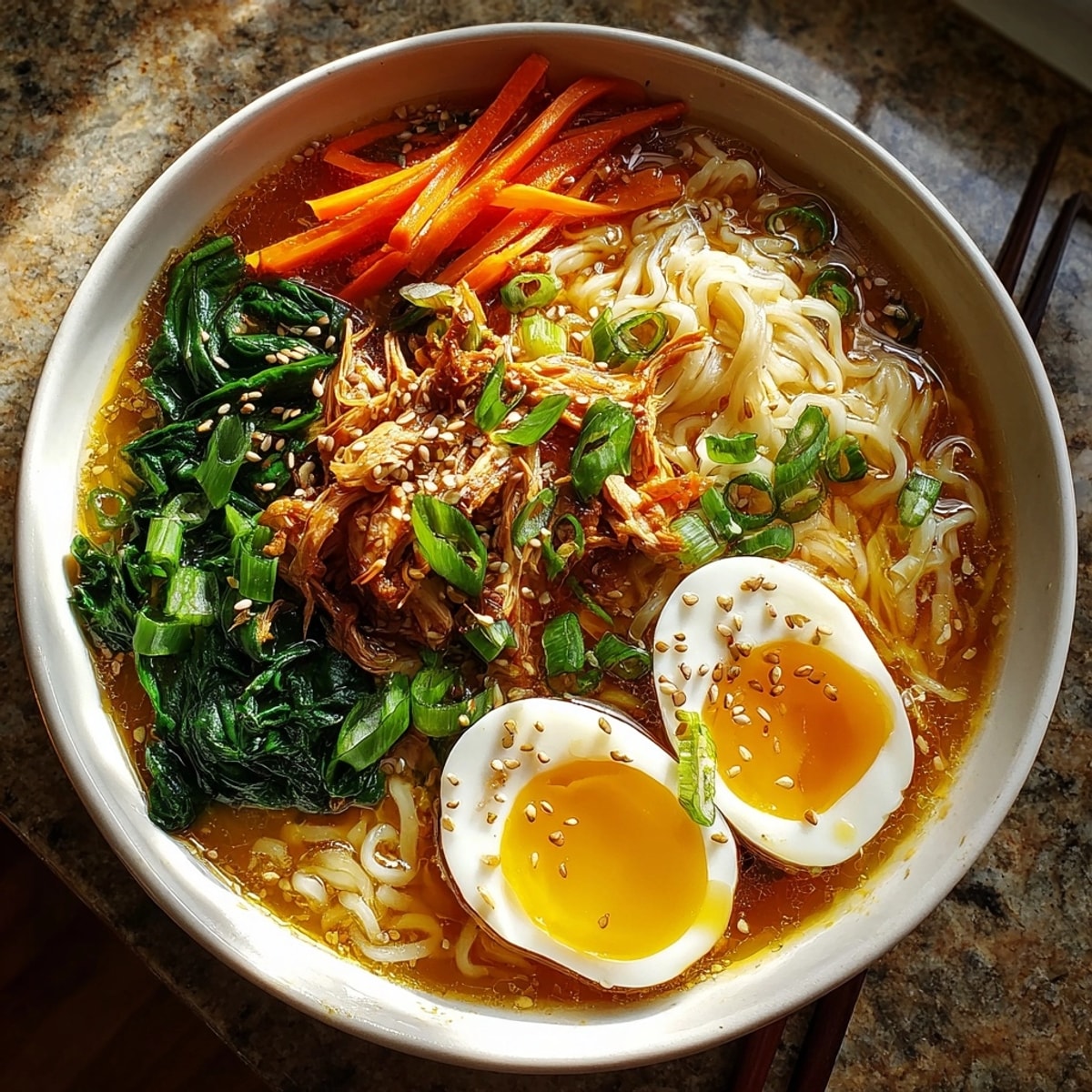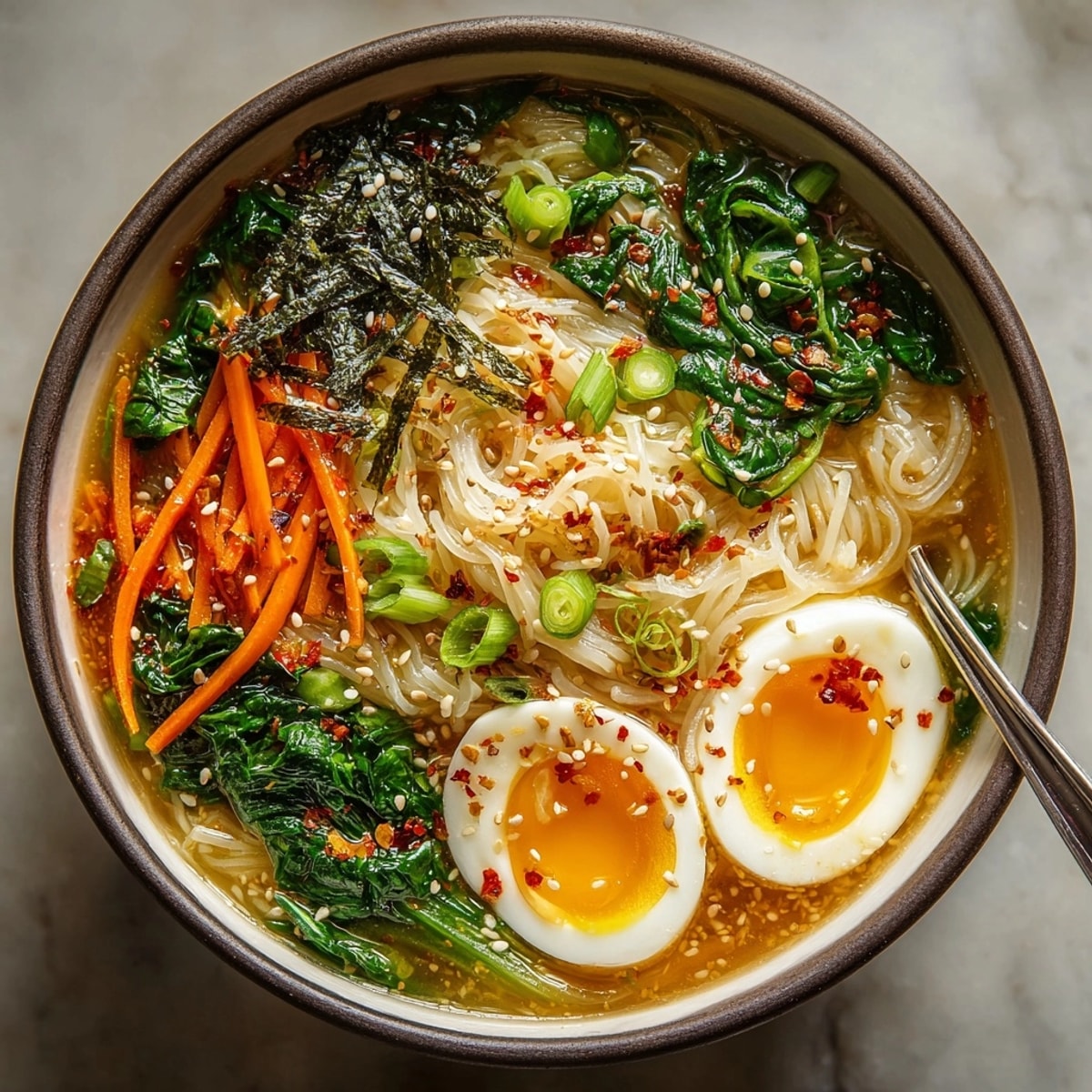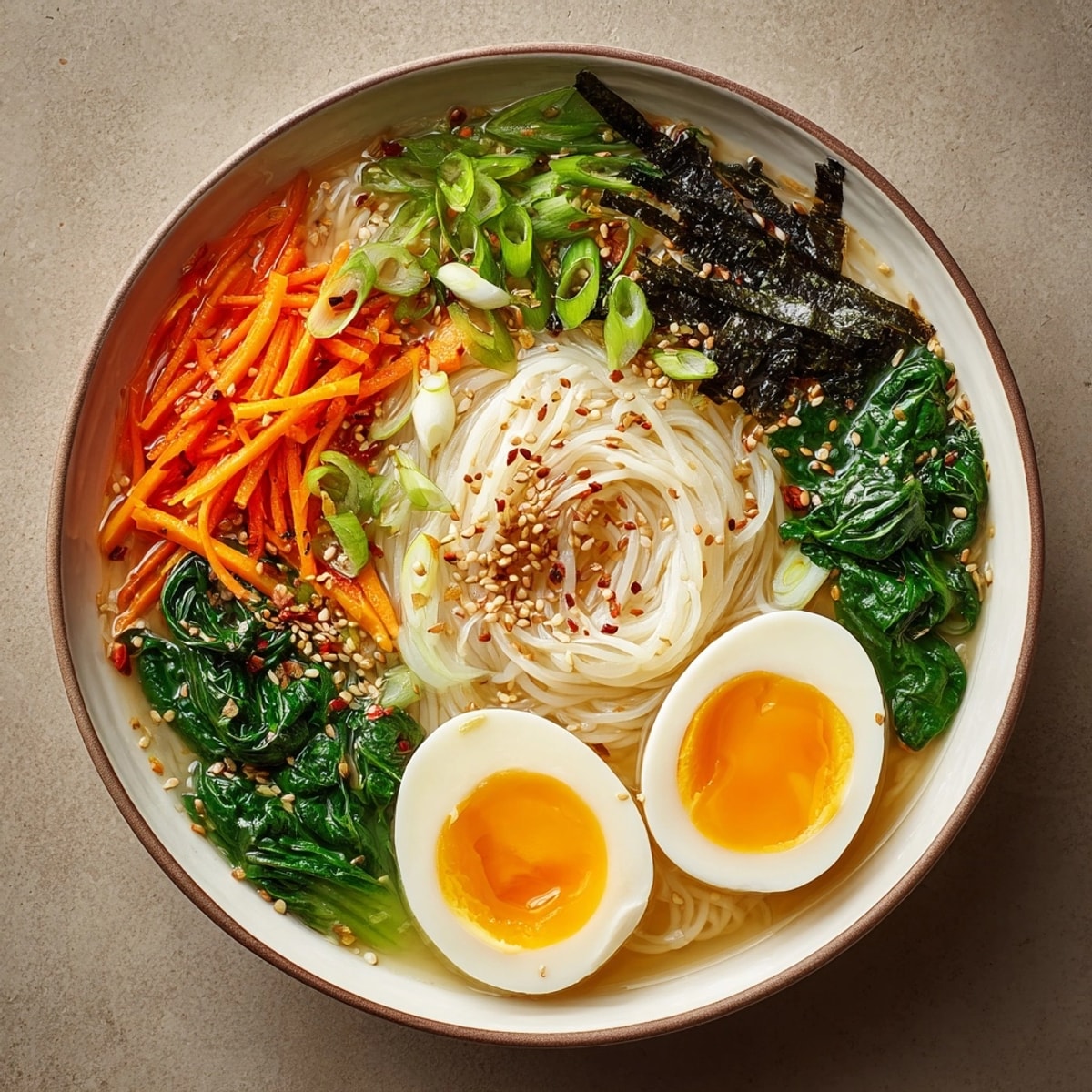 Save
Save This shirataki noodle ramen transforms a traditionally carb-heavy dish into a light yet satisfying meal that won't weigh you down. The delicate egg "cloud" floats atop a savory umami broth, creating a comforting bowl that feels indulgent while remaining low in calories and carbs.
I first discovered shirataki noodles during my weight loss journey three years ago, and this ramen has become my go to comfort food. My family now requests it weekly, even though they typically prefer traditional pasta dishes.
Ingredients
- 2 packages shirataki noodles 400g: These miracle noodles contain almost zero calories while providing the perfect chewy texture for ramen.
- 4 cups low sodium chicken broth: The foundation of our soup provides rich flavor without excess salt. Homemade is best but quality store bought works wonderfully.
- 2 tablespoons soy sauce: Adds essential umami depth. Choose a naturally brewed variety for best flavor.
- 1 tablespoon white miso paste: Creates complexity and body in the broth. Look for refrigerated miso for optimal freshness.
- 1 teaspoon sesame oil: A little goes a long way in providing authentic nutty aroma.
- 1 teaspoon grated fresh ginger: Adds bright zingy notes. Always use fresh rather than powdered for this recipe.
- 1 garlic clove minced: Provides aromatic foundation. Fresh is essential here.
- 1 teaspoon rice vinegar: Balances flavors with subtle acidity.
- 2 large eggs: Creates our signature cloud effect. Farm fresh eggs with vibrant yolks make a visual difference.
- 100g baby spinach: Adds color, nutrition and tender texture.
- 1 small carrot julienned: Provides sweet crunch and visual appeal.
- 2 scallions thinly sliced: Adds fresh onion flavor and bright color contrast.
- 1 tablespoon toasted sesame seeds: Provides nutty crunch and visual interest.
Instructions
- Prepare the Noodles:
- Thoroughly rinse shirataki noodles under cold running water for at least 30 seconds to remove their packaged liquid. This step is crucial as it eliminates any fishy smell that might otherwise affect your dish. After rinsing, drain them completely in a colander while you prepare the other ingredients. For extra texture, you can dry roast them in a hot pan for 1 minute before adding to the broth.
- Perfect the Egg Cloud:
- Bring a small pot of water to a rolling boil over high heat. Using a slotted spoon, gently lower room temperature eggs into the water to prevent cracking. Set a timer for exactly 6 minutes to achieve that perfect soft boiled consistency with firm whites and jammy yolks. Immediately transfer to an ice bath to stop cooking and make peeling easier. The temperature contrast creates that separation between shell and egg membrane.
- Create the Flavor Base:
- Heat sesame oil in a medium pot over medium heat until shimmering but not smoking. Add minced garlic and grated ginger, stirring constantly to prevent burning. Cook for exactly 60 seconds until fragrant and slightly softened but not browned, as overcooked garlic becomes bitter. This aromatic foundation infuses the entire broth with essential flavor compounds.
- Develop the Broth:
- Pour chicken broth into the pot with aromatics and bring to a gentle simmer. Whisk in miso paste until completely dissolved, ensuring no lumps remain. Add soy sauce and rice vinegar, then allow to simmer for 5 minutes to marry the flavors. Taste and adjust seasoning as needed. The broth should be rich and complex with balanced salt, umami and subtle acidity.
- Add Vegetables:
- Add julienned carrots to the simmering broth and cook for 2 minutes until slightly softened but still maintaining some crunch. Stir in baby spinach and watch it wilt almost immediately, about 30 seconds. The residual heat will continue cooking the vegetables to perfect tenderness while maintaining their vibrant colors.
- Incorporate Noodles:
- Add the thoroughly rinsed shirataki noodles to the broth and simmer for 2 minutes to heat through and allow them to absorb the savory flavors. Unlike wheat noodles, shirataki will not overcook or become mushy, so timing is less critical here. They should take on the color and flavor of your broth while maintaining their unique bouncy texture.
- Assemble Your Ramen Bowl:
- Using tongs, divide the noodles between two serving bowls, then ladle the hot broth with vegetables over top. Arrange the components aesthetically with noodles as the base and vegetables distributed throughout for visual appeal. Leave space in the center for your egg cloud.
- Create the Egg Cloud Effect:
- Carefully slice each peeled soft boiled egg in half lengthwise, revealing the jammy yolk inside. Place both halves on top of each bowl with yolks facing upward to create the cloud effect. The heat from the broth will warm the eggs without further cooking them, maintaining that perfect soft texture.
- Finish with Garnishes:
- Sprinkle each bowl with sliced scallions, focusing on the vibrant green parts for color contrast. Add toasted sesame seeds around the edge of the bowl and place nori strips partially submerged in the broth. For those who enjoy heat, add a small drizzle of chili oil in a circular pattern around the eggs.
 Save
Save The shirataki noodles are truly the star of this dish. I discovered them during a particularly strict diet phase and was skeptical at first. But after learning proper preparation techniques, they became my secret weapon for enjoying my favorite comfort foods without derailing my health goals. My husband now prefers them to regular noodles in many Asian dishes.
Storage Tips
This ramen stores beautifully when components are kept separate. Store the broth in an airtight container in the refrigerator for up to 3 days. Keep prepared noodles separately in cold water to prevent them from drying out. For best results, prepare fresh eggs just before serving rather than storing them cooked.
If freezing, store only the broth without noodles or vegetables for up to 3 months. The texture of shirataki noodles can become rubbery when frozen, so always use fresh noodles when reheating frozen broth. Simply thaw broth overnight in the refrigerator and bring to a simmer before adding fresh vegetables and noodles.
Ingredient Substitutions
The beauty of this recipe lies in its flexibility. For a vegetarian version, simply swap the chicken broth for vegetable broth or mushroom broth for deeper umami flavor. If eggs are not your preference, substitute with pan seared tofu cubes or tempeh for protein.
Shirataki noodles come in various shapes. If you cannot find the traditional noodle form, try shirataki rice or fettuccine shapes. For those avoiding soy, konjac only shirataki noodles are available that contain no tofu or soy products.
Miso paste varieties can significantly change the flavor profile. White miso creates a more delicate flavor, while red miso offers a stronger, more robust taste. If miso is unavailable, substitute with 1 tablespoon tahini mixed with 1/2 teaspoon soy sauce.
Serving Suggestions
Serve this ramen as a light lunch or pair it with gyoza dumplings or a simple cucumber salad for a more substantial meal. For added protein, top with thinly sliced chicken breast, shrimp, or tofu.
A crisp Japanese beer or chilled sake complements the umami flavors perfectly. For non alcoholic options, green tea or cold mugicha barley tea provides a refreshing contrast to the warm broth.
Present in traditional ramen bowls for the most authentic experience. Offer additional condiments tableside like togarashi spice blend, extra chili oil, or pickled ginger to allow diners to customize their bowls.
Seasonal Adaptations
Spring variation Add fresh peas, asparagus tips, and a sprinkle of microgreens for brightness
Summer version Incorporate fresh corn kernels, cherry tomatoes, and serve with a side of chilled cucumber salad
Fall adaptation Include roasted mushrooms, kabocha squash cubes, and a drizzle of pumpkin oil
 Save
Save I hope this shirataki noodle ramen brings as much comfort to your table as it has to mine. The beauty of this dish is how it transforms humble ingredients into something that feels special yet remains nourishing. Whether you're following a specific eating plan or simply looking for a lighter alternative to traditional ramen, this recipe proves that wholesome food can be both satisfying and delicious.
Recipe FAQ
- → What’s the best way to prepare shirataki noodles for this dish?
Rinse the shirataki noodles thoroughly under cold water, then drain well. This removes any natural odor and ensures a pleasant texture in the bowl.
- → How do I achieve a perfectly soft-boiled egg cloud?
Boil the eggs for 6 minutes, then transfer to ice water to stop the cooking. Peel gently and halve before placing on top of each bowl.
- → Can I make this bowl vegetarian and gluten-free?
Use vegetable broth and opt for tamari instead of soy sauce. To make it vegetarian, replace the egg with tofu as desired and ensure miso is gluten-free.
- → What vegetables can I add for variety?
Bok choy, mushrooms, or even bell peppers can be added to the broth for extra color, texture, and nutrition. Adjust cooking times to suit each addition.
- → How do I adjust the seasoning?
Taste the broth before serving and add more miso or soy sauce for extra umami or saltiness. A drizzle of chili oil adds heat if desired.
- → What are some recommended garnishes?
Scallions, toasted sesame seeds, sliced nori, and a touch of chili oil provide layers of flavor and attractive presentation.